Oral
MRI for Psychopathology
ISMRM & ISMRT Annual Meeting & Exhibition • 04-09 May 2024 • Singapore

| 08:15 |
0434.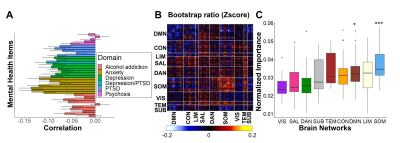 |
Brain functional connectome phenotype relates to psychopathology
in middle-aged and older adults
Thuan Tinh Nguyen1,2,
Kwun Kei Ng1,
Janice Jue Xin Koi1,
and Juan Helen Zhou1,2,3
1Centre for Sleep and Cognition & Centre for Translational Magnetic Resonance Research, National University of Singapore, Singapore, Singapore, 2Integrative Sciences and Engineering Programme, National University of Singapore, Singapore, Singapore, 3Department of Electrical and Computer Engineering, National University of Singapore, Singapore, Singapore Keywords: Psychiatric Disorders, Psychiatric Disorders Motivation: To better understand brain network vulnerability in mental health disorders in the understudied middle-aged and older adults and see if it fits the hierarchical model of psychopathology. Goal(s): We sought to unveil the structure of psychopathology through investigating the brain phenotypes underlying various mental outcomes using the UK Biobank cohort. Approach: We investigated how brain functional connectivity relates to 36 mental outcome items using a multivariate partial least squares correlation approach. Results: Across middle-aged and older adults, we identified a general disease factor and another reflecting the divergence between alcohol addiction and depression/PTSD related symptoms, consistent with the hierarchical model of psychopathology. Impact: These findings highlighted the importance of characterizing mental disorders in terms of transdiagnostic dimensions instead of separate disorders. It also shed light on how imaging biomarkers can be used to characterize population suffering from poor mental health. |
| 08:27 |
0435.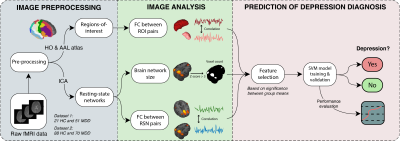 |
Explainable depression classification: a machine learning
approach based on brain network size and functional connectivity
Jesper Pilmeyer1,2,
Lisa Koolen1,
Marcel Breeuwer1,3,4,
Jacobus F.A. Jansen1,5,6,
and Svitlana Zinger1,2
1Electrical Engineering, Eindhoven University of Technology, Eindhoven, Netherlands, 2Research and Development, Epilepsy Centre Kempenhaeghe, Heeze, Netherlands, 3Biomedical Engineering, Eindhoven University of Technology, Eindhoven, Netherlands, 4Philips Healthcare, Best, Netherlands, 5Radiology and Nuclear Medicine, Maastricht University Medical Center, Maastricht, Netherlands, 6School for Mental Health and Neuroscience, Maastricht University, Maastricht, Netherlands Keywords: Psychiatric Disorders, Psychiatric Disorders, depression Motivation: Major depressive disorder (MDD) affects ~6% of adults annually worldwide, but a lack of understanding of the pathology and heterogeneity may underlie its low treatment effectiveness. Goal(s): This study aimed to identify explainable functional MRI biomarkers of MDD on an individual level. Approach: Classification models were run to predict MDD for three functional measures. Results: In two datasets, >70% MDD accuracy was achieved for each measure. Highest performance was obtained with region-based functional connectivity but spatial extent provided novel perspectives on abnormal brain functioning, such as decreased cerebellum involvement in the frontoparietal network, potentially reflecting decreased emotion regulation or control during cognitive processes. Impact: This MRI research contributes to the identification of robust depression biomarkers, enhancing our understanding of the abnormal brain functioning. The explainability of the spatial extent feature provides additional insights into its pathology which may be utilized for diagnostic tools. |
| 08:39 |
0436.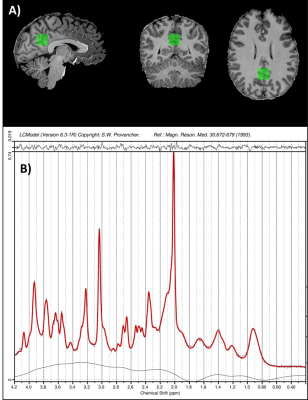 |
Pilot Results Investigating Treatment Effects on
Neurometabolites in Major Depressive Disorder: A 7T MRS Study of
the Posterior Cingulate Cortex
Ravichandran Rajkumar1,2,3,4,
Ezequiel Farrher2,
Gereon J Schnellbächer1,2,
Jana Hagen1,2,
Maria Collee1,2,
Shukti Ramkiran1,2,4,
Alna Reem Al Latheef1,2,
Tanja Veselinović1,
N. Jon Shah2,3,5,6,
and Irene Neuner1,2,3,4
1Department of Psychiatry, Psychotherapy and Psychosomatics, RWTH Aachen University, Aachen, Germany, 2Institute of Neuroscience and Medicine, INM-4, Forschungszentrum Jülich, Juelich, Germany, 3JARA – BRAIN – Translational Medicine, Aachen, Germany, 4Center for Computational Life Science, RWTH Aachen University, Aachen, Germany, 5Department of Neurology, RWTH Aachen University, Aachen, Germany, 6Institute of Neuroscience and Medicine, INM-11, Forschungszentrum Jülich, Juelich, Germany Keywords: Psychiatric Disorders, Psychiatric Disorders, MRS, MDD, Neurotransmitters, UHF Motivation: This research addresses a critical gap by investigating the impact of depression treatment on neurometabolites in the PCC. Goal(s): This exploratory study aims to investigate the relationship between neurometabolite levels in the PCC and assess its impact on treatment. Approach: Structural MRI and MRS data were acquired from 16 MDD patients and 16 healthy controls. The concentration of neurometabolites was quantified. ANOVA models were used to assess differences between groups. Results: Treatment effectively reduced depressive symptoms but did not significantly alter neurometabolite levels in the PCC. Factors such as medication, small sample size, and short follow-up intervals may have contributed to these results. Impact: This research highlights that, despite effective treatment response in improving depressive symptoms in MDD patients, neurometabolite levels in the PCC were not significantly altered, emphasizing the necessity for further, more extensive research to comprehensively understand MDD and its treatment. |
08:51 |
0437.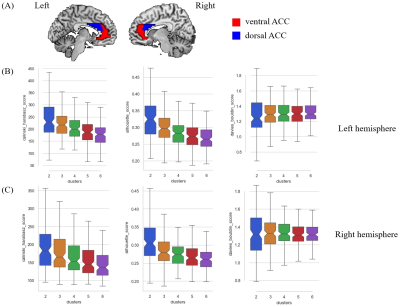 |
Distinct functional connectivity of anterior cingulate cortex
subregional networks in first-episode and recurrent major
depressive disorder
Zilin Zhou1,
Lingxiao Cao1,
Yingxue Gao1,
Weijie Bao1,
Mengyue Tang1,
Hailong Li1,
Lianqing Zhang1,
Huaiqiang Sun1,2,
Qiyong Gong3,
and Xiaoqi Huang1,2
1Department of Radiology and Huaxi MR Research Center (HMRRC), Functional and Molecular lmaging Key Laboratory of Sichuan Province, West China Hospital, Sichuan University, Chengdu, China, 2Research Unit of Psychoradiology, Chinese Academy of Medical Sciences, Chengdu, China, 3Department of Radiology, West China Xiamen Hospital of Sichuan University, Xiamen, China Keywords: Psychiatric Disorders, fMRI (resting state), major depresive disorder Motivation: The fine-grained anterior cingulate cortex (ACC) subregional functional connectivity alterations in first-episode and recurrent major depressive disorder (MDD) remained unclear. Goal(s): To obtain optimal functional ACC subdivisions and explore alterations in intrinsic functional connectivity of ACC subregional networks in first-episode and recurrent MDD. Approach: We utilized a data-driven connectivity-based parcellation to obtain optimal ACC subdivisions, calculated ACC subregional functional connectivity, and compared among first-episode, recurrent MDD patients and healthy controls. Results: Ventral and dorsal ACC per hemisphere were identified as optimal parcellation. The ACC subregional connectivity was reduced in all MDD patients, while dorsal ACC connectivity was significantly reduced only in recurrent patients. Impact: Our discovery of impaired functional architectures of ACC subdivisions in MDD, with a more prominent disrupted connectivity of dorsal ACC in relapsed patients, emphasize a potential role of ACC subregional connectivity in distinguishing MDD at different episodes and predicting relapse. |
| 09:03 |
0438.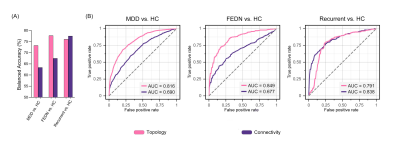 |
Abnormal Topology and Connectivity of Structural Covariance
Network Related to Diagnosis and Phenotyping in Major Depressive
Disorder
Kun Qin1,
Jing-Yi Long2,
Nanfang Pan3,
Cunqing Kong1,
Weiyin Vivian Liu4,
Wen Chen1,
and Yi Li2
1Department of Radiology, Taihe Hospital, Hubei University of Medicine, Shiyan, China, 2Wuhan Mental Health Center, Wuhan, China, 3West China Hospital of Sichuan University, Chengdu, China, 4GE Healthcare, MR Research China, Beijing, China Keywords: Psychiatric Disorders, Brain Connectivity Motivation: Findings on brain network abnormalties in major depressive disorder (MDD) were mixed owing to small-scale and single-site designs. The diagnostic value of network topology and connectivity remain unclear. Goal(s): To identify robust structural network abnormalities in MDD and relevant clinical phenotypes and to discern the diagnostic value of network topology and connectivity. Approach: Group-level comparsion and individual-level machine learning classification was performed based on structural covariance network connectivity and topological metrics. Results: Different patterns of network topology and connectivity abnormalities were observed between first-episode drug-naive and recurrent patients with MDD. Topological metrics enabled more accurate classification performance on MDD diagnosis and phenotyping. Impact: Our findings advance the current understanding of network-level neurobiological mechanisms of MDD, providing a solid basis for future development of network topology-based diagnosis models. |
| 09:15 |
0439.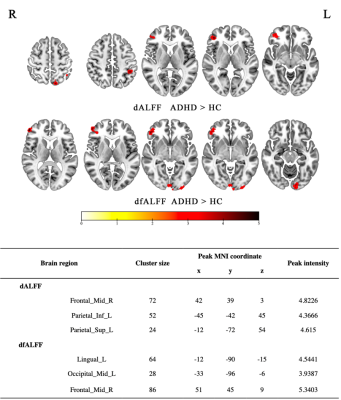 |
Dynamic alterations in spontaneous neural activity in patients
with attention-deficit/hyperactivity disorder: a resting-state
fMRI study
Rui Hu1,2,
Wei Du1,
Fan Tan2,
Yong Wu2,
Wen Chen2,
and Yanwei Miao1
1The First Affiliated Hospital of Dalian Medical University, Dalian, China, 2Taihe Hospital, Hubei University of Medicine, Shiyan, China Keywords: Psychiatric Disorders, fMRI (resting state), attention-deficit/hyperactivity disorder Motivation: The dALFF and dfALFF of ADHD have not been fully revealed and publicized. Goal(s): We investigate dALFF and dfALFF in ADHD and further explore whether dALFF and dfALFF can be used to test the feasibility of differentiating ADHD from HC. Approach: The ALFF and fALFF methods were combined with sliding-window approaches to investigate the abnormal time-varying local brain activity of ADHD. Results: ADHD showed statistically significant differences in dALFF and dfALFF. Clinical scores and executive function were correlated with the quantitative values of dynamic differential brain regions. ADHD and HC can be effectively distinguished using an auxiliary diagnostic model based on random forest. Impact: From the perspective of dynamic local brain activity, this study provides insight into the brain dysfunction of ADHD. Understanding dALFF/dfALFF variability can be helpful in understanding neurophysiological mechanisms and possibly guiding ADHD diagnosis. |
09:27 |
0440.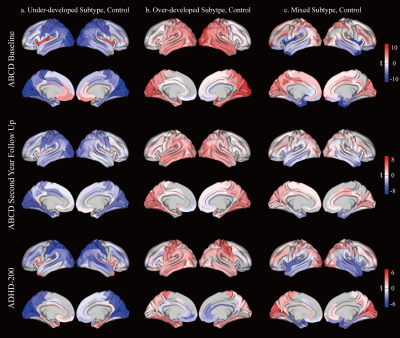 |
Distinct Neuroimaging Subtypes within ADHD Population Based on
Semi-supervised Learning
Yiwei Chen1,
Mingyang Li1,
Tianshu Zheng1,
Xinyi Xu1,
Ruoke Zhao1,
Ruike Chen1,
Haoan Xu1,
Yuqi Zhang1,
Guanghai Wang2,
and Dan Wu1
1Department of Biomedical Engineering, Zhejiang University, Hangzhou, China, 2Department of Developmental and Behavioral Pediatrics, Shanghai Jiao Tong University School of Medicine, Shanghai, China Keywords: Psychiatric Disorders, Psychiatric Disorders, Cortical Thickness, Disease Subtype, Generative Adversarial Network Motivation: Attention deficit hyperactivity disorder (ADHD) is a childhood-onset disease whose diagnosis and subtyping methods are primarily based on clinical traits, which is prone to subjectivity and instability. Also, the patient outcome and neuroimaging signatures of these subtypes are not clear. Goal(s): We aimed to use a data-driven approach for subtyping. Approach: We used a semi-supervised learning method based on 929 ADHD patients selected from ABCD study. Results: We identified three distinct subtypes in ADHD based on cortical thickness (under-developed, over-developed, and mixed subtypes). Follow-up analysis found significant differences in cognitive and behavior outcomes, disease progression, and response to medication among the subtypes. Impact: We identified three distinct subtypes in ADHD based on cortical thickness (under-developed, over-developed, and mixed subtypes), with unique cognitive, behavioral, progression profiles, and treatment responses. These findings may shed insights into personalized treatment in ADHD. |
| 09:39 |
0441.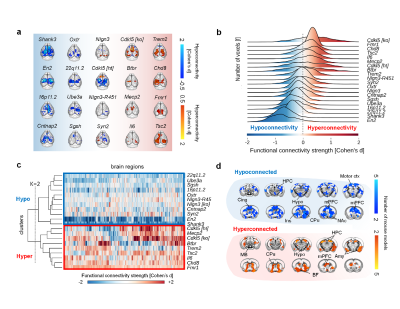 |
Cross-species fMRI reveals transcriptomically and
behaviorally-dissociable autism neurosubtypes
Marco Pagani1,2,
Valerio Zerbi3,
Alberto Galbusera1,
Filomena Alvino1,
Ting Xu2,
Michael Lombardo1,
Michael Milham2,
Adriana Di Martino2,
and Alessandro Gozzi1
1IIT, Rovereto, Italy, 2CMI, New York, NY, United States, 3ETH, Zurich, Switzerland Keywords: Psychiatric Disorders, Brain Connectivity Motivation: Resting-state fMRI (rsfMRI) studies have revealed atypical patterns of functional connectivity in autism. However, large heterogeneity in the manifestation of these alterations exists across samples and its etiopathological significance remains unclear. Goal(s): Here, we used cross-species rsfMRI to probe if distinct patterns of functional dysconnectivity observed across 20 genetic models can be identified in rsfMRI scans of individuals with idiopathic autism. Approach: We mapped whole brain functional connectivity in 20 genetic mouse models and in over 2000 individuals with and without autism. Results: Our work reveals two autism neurosubtypes characterized by divergent patterns of dysconnectivity, and dissociable transcriptomic and behavioral profiles. Impact: Connectivity alterations in idiopathic autism encode for etiologically-relevant information. |
| 09:51 |
0442.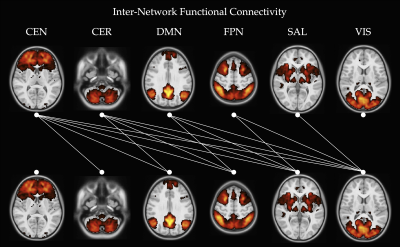 |
Altered Functional Connectivity of Resting State Networks in
Children with Sensory Over-Responsivity But Not Autism
Hannah L. Choi1,
Rachel Powers2,
Maia C. Lazerwitz2,
Lanya T. Cai1,
Annie Brandes-Aitken2,
Robyn Chu2,
Kaitlyn J. Trimarchi2,
Rafael D. Garcia2,
Elysa J. Marco2,3,
and Pratik Mukherjee1
1Department of Radiology and Biomedical Imaging, University of California San Francisco, San Francisco, CA, United States, 2Cortica Healthcare, San Rafael, CA, United States, 3Lifetime Neurodevelopmental Care Center, San Rafael, CA, United States Keywords: Neuro, fMRI (resting state), Functional Connectivity, fMRI, Sensory Processing Disorder, Sensory Over-Responsivity Motivation: Sensory Over-Responsivity (SOR) adversely impacts over 2.5% of children, prompting a study into its neural correlates in the absence of ASD to comprehend its unique effect on brain function. Goal(s): We test the hypothesis that SOR in non-ASD children is linked to impaired connectivity in sensory networks and alterations in higher-order, regulatory networks. Approach: Functional brain networks are constructed and analyzed using ICA, dual regression, fractional amplitude of low-frequency fluctuations (fALFF), and regional homogeneity (ReHo). Results: SOR children exhibit increased functional connectivity in default-mode, frontoparietal, and salience networks, alongside reduced connectivity in visual and cerebellar networks, confirming a distinctive neural profile of SOR. Impact: This study reveals distinct functional connectivity in SOR. It establishes a basis for novel interventions and tailored medical approaches for children, with or without ASD, encouraging further investigation into the neural basis and management of sensory processing disorders. |
| 10:03 |
Discussion
Anouk Schrantee
Amsterdam University Medical Center, Amsterdam,
Netherlands
|
The International Society for Magnetic Resonance in Medicine is accredited by the Accreditation Council for Continuing Medical Education to provide continuing medical education for physicians.